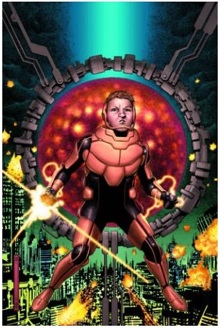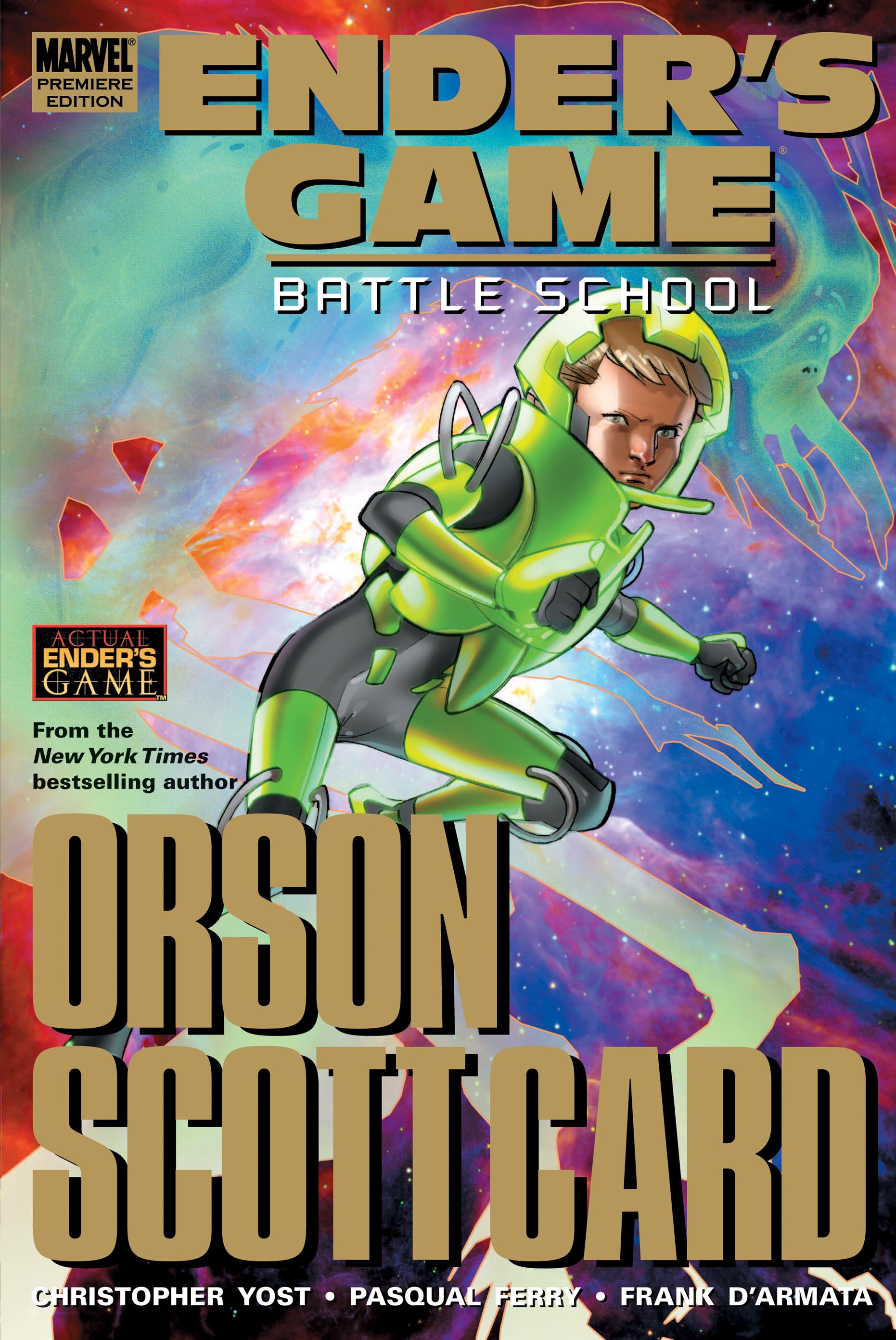I am frequently asked “Why hasn’t science fiction produced its own Harry Potter?” and the answer is that is it already has, and over twenty-five years ago. In fact, long before Hogwarts, the world was already celebrating a wiz kid of exceptional ability, taken from an intolerable domestic situation, and thrust into an incredibly high-pressure scholastic environment, where he would assemble a group of seemingly dysfunctional students into an ace team, all while laboring under the crushing expectation that he alone could beat the ultimate bad guy. That novel, of course, was Orson Scott Card’s Ender’s Game. And given the elements above, along with the masterful way they play out, it should come as no surprise then that Ender’s Game won both the Hugo and Nebula Awards, spawned multiple sequels, became a commercial juggernaut today, and has emerged as one of the most popular and enduring works of science fiction literature of all time.
No wonder then that on the heels of their success with Stephen King’s Dark Tower comic book that Marvel comics would turn to the creative team of writer Christopher Yost (Killer of Demons, X-Force, Red Robin) and artist Pasqual Ferry (Ultimate Fantastic Four, Ultimate Iron Man) for an Ender’s Game comic book, nor that a great deal of anticipation would surround the project.
For my own part, it was very interesting to follow Ender’s Game into a new medium. I read the original novella, and listened to the audiobook (unabridged, with an actual cast that includes Harlan Ellison of all people), and now I am experiencing Ender’s Game in comic form. Right off, I have to say it lent itself exceptionally well, perhaps better than I anticipated, and I hope that having it all story-boarded out so nicely will help Hollywood see the potential and get its act together when it comes to the Ender’s Game movie. In fact, Card himself said, “I’m thrilled because this is actually the first move of Ender’s Game into a visual medium,” and, indeed, it is true that often times it takes a visual representation of a novel for Hollywood to “see” how a novel might be visualized (this was how The Matrix was pitched to Warner Bros., for example.)
And speaking visually, one of the things that impressed me the most was the way the artist took the basic visual component of the battle room—essentially a featureless or feature-light grid—and extended that outward across the entire environment. So the Wiggin family house, Ender’s school, government offices, are all rendered with an architect’s precision and attention to detail, and become these eye-catching diagrams of planes and angles. There isn’t a lot of detail in the book to suggest what this future looks like; at least it’s loose enough that a visual representation could go in multiple directions.  Fortunately, Ferry’s design for this future, which I understand he achieved in collaboration with Card himself, was gorgeous. Environments are interesting, sufficiently “futuristic,” while being utterly plausible, natural extensions of the more modern buildings and dwellings we have today. The Wiggin home looked like some of the ultra-modern houses you might see showcased on Extreme Homes on the Home & Garden channel (and not even the extreme ones), just ultra-modern, space efficient homes with lots of glass to take advantage of natural light. If I harp on this aspect of the art, it’s because more than anything else, the comic showed me how accessible, and how cinematic, Ender’s Game is, and how an Ender’s Game film should look. Science fiction is often characterized, rightly or wrongly, as a cold and alienating genre, whereas the look of this tale is one of an accessible world I wouldn’t mind living in (at least until you get to the desperation of the narrative).
Fortunately, Ferry’s design for this future, which I understand he achieved in collaboration with Card himself, was gorgeous. Environments are interesting, sufficiently “futuristic,” while being utterly plausible, natural extensions of the more modern buildings and dwellings we have today. The Wiggin home looked like some of the ultra-modern houses you might see showcased on Extreme Homes on the Home & Garden channel (and not even the extreme ones), just ultra-modern, space efficient homes with lots of glass to take advantage of natural light. If I harp on this aspect of the art, it’s because more than anything else, the comic showed me how accessible, and how cinematic, Ender’s Game is, and how an Ender’s Game film should look. Science fiction is often characterized, rightly or wrongly, as a cold and alienating genre, whereas the look of this tale is one of an accessible world I wouldn’t mind living in (at least until you get to the desperation of the narrative).
As to that narrative, it translates to the graphic medium surprisingly well. It is notable how unsettling the violence is when graphically portrayed. Ender is a child, and it is one thing to read about a child beat another to death, quite another to see it. This is a harsh story, and an adult one, powerful and uncompromising. In creating the comic, Yost and Ferry have preserved this perfectly, without compromises. (The comic comes with a PARENTAL ADVISORY warning, and this is a good thing. And a good thing.) The power of the story is there on the page. And while they are covering a lot of ground in a a few pages, they seem to have it all there. Aspects like the Gaint’s Drink—a videogame crafted by the school administrators to model student behavior, with it own version of a Kobayashi Maru-esque unwinnable scenario (the novella does predate Wrath of Khan, by the way)—show how much Card himself prefigured videogaming when he originally wrote the novel. I wasn’t sure that the rules for the Battle Room were delineated clearly enough for the uninitiated, but that isn’t something I can really judge, as familiar with the original as I am. Also, the mechanics of the games aren’t what matters; it’s the dynamics of the characters. This adaptation of Ender Wiggin’s unbearable circumstances felt every bit as dramatic, painful, unsettling as the novel, and every bit as exciting. Lines like, “Knocking him down won the first fight. I needed to win all the next ones, too” contained all the power and pathos they always did.
These first five issues take us to the point where General Graff decides to issue Ender his first command position in the Battle School, and pave the way for the next installment, Ender’s Game: Command School. This is my first exposure to the works of Yost and Ferry, and, in fact, I didn’t know when I initially agreed to review the comic here for Tor.com that I wasn’t getting “the whole story” complete in one volume. It’s a measure of how utterly effective they are in this adaptation that I can hardly wait for the second part, and I will certainly check out more work from these creators. Meanwhile, I’ll be back before then with a review of Ender’s Shadow: Battle School.











The difference between Harry Potter and Ender’s Game is that with Harry Potter every book was better than the one before it and with Ender Wiggin, every book was worse.
Actually, I think the biggest difference is that the direct sequels were about Ender’s adult life. To really be compared to the Harry Potter series, Ender’s Game would have had to have been stretched into a series in and of itself, with each book being a year in the battle school, or something similar.
That said, I am totally looking forward to this comic and completely agree that, done properly, Ender’s Game would make a great movie.
Maybe it’s the lack of a “franchise” surrounding it that is still keeping Hollywood from picking it up.
When I first saw the title of this article I got really excited because I thought it was going to be about the video game based on Ender’s Game. That’s Battle Room, though, not Battle School. Drat.
Great article and a great reminder about some of the good books out there. What I don’t get is why everyone insists on carrying on like Harry Potter is some sort of holy grail of literature that all writers should be aspiring to. Yes it is popular (or was when it first came out and is every time a movie opens) but is popularity really what writers should be aiming for. Those that try usually miss or rewrite books that were far superior in there original format. Writers should aim for quality and if it happens to become a sensation, wow!
When I first read Ender’s Game, I thought it was pretty good, if written in a very dry style. I like the Harry Potter books better, if only for the higher-quality prose.
Also, I have had a really hard time enjoying Ender’s Game since I found out Orson Scott Card is a homophobe. Great art lives on its own merits, sure, but I’m glad I bought the book second-hand so Card didn’t get royalties from the sale.
Higher quality? Card is a far superior writer compared to Rowling.
Well, Harry Potter isn’t morally reprehensible, that’s one thing in his favor over Card’s “hero.”
Read more about Ender, “a character who exterminates an entire race and yet remains fundamentally innocent,” here:
http://www4.ncsu.edu/~tenshi/Killer_000.htm
This comment has nothing to do with the comic and instead focuses on the introductory comparison ;)
Agreed with #6, if I had a penny for every word ending in -ly in an HP book I’d be nearly half as rich as JKR.
For me the main difference between Ender and Harry is that Ender actually is a bit special and unique. Harry on the other hand is a bit, well, rubbish.
Sure he’s got the same “The world rests on your shoulders” gig, but it seems to happen in spite, and not because, of his actual involvement. HP spent 5 of the 7 books being a whiny, emo teenager with communication issues, i.e. normal.
@7 I wouldn’t go so far as saying Ender is morally reprehensible, I’d certainly want my kids growing up more Harry-like. But if the fate of the world depends on it I’d trust Ender to get. shit. done.
And stay the hell out of his way.